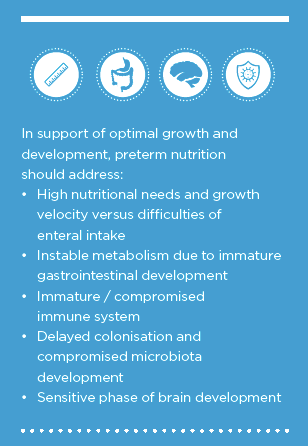Several studies have shown that growth failure of preterm infants affects health in later life and compromises brain development ¹`². Therefore, avoiding growth failure is a central challenge in preterm nutrition ¹⁻³.
Preventing growth failure
Preterm infants have increased nutrient requirements to achieve the growth velocity of a child growing in its mother’s womb ⁴`⁵ . These requirements are much higher than those of a term born peer ⁴⁻⁶. Medical associations such as the European Society for Gastroenterology, Hepatology, and Nutrition (ESPGHAN)⁶ and American Academy of Pediatrics (AAP) ⁷ as well as neonatal experts⁸ address these requirements by giving specific recommendations for premature infants born weighing less than 1000g, less than 1500g and less than 1800g. All these associations acknowledge that protein is a key nutrient in avoiding growth failure as long as enough energy is provided⁶⁻⁸.

Breast is best
In line with the World Health Organisation (WHO) we believe that human milk is the best nutrition for preterm infants⁹. Breastfeeding and human milk (HM) are the preferred feeding mode and nutrition for every infant¹⁰⁻¹³.
The composition of HM is highly variable and tailored to the personal nutritional needs of an infant¹⁴⁻¹⁶. For preterm infants on parenteral feeds, trophic feeding with HM soon after birth is recommended to prepare the intestine for enteral feeding³`¹¹`¹².
Maternal human milk benefits
Beyond the benefits of breastfeeding known for term infants ¹⁷, providing HM to premature infants:
- offers immune protection against infection ³`¹¹`¹².
- reduces the risk of necrotising enterocolitis (NEC) ³`¹¹`¹².
- prepares the gut for enteral feeding ³`¹¹`¹².
- supports healthy gut development ³`¹¹`¹².
- provides enzymes for fat absorption¹².
- is associated with improved neurocognitive development³`¹¹`¹².
- is tolerated well ³`¹¹`¹², and personalised to the mother-infant¹⁵`¹⁶.
Colostrum, a pre-milk fluid rich in immunoglobulins and immune cells that is produced during the first 24–48 hours postpartum, is especially important for immune protection and gut maturation and should never be discarded¹².
Donor human milk
If own mothers milk (OMM) is not available donor human milk (DHM) from milk banks is the next preferred alternative for preterm infant feeding¹³. However, as with OMM, DHM is not nutrient enriched enough to meet the high requirements of extreme and very premature infants and fortification i.e. adding macro- and micronutrients to HM or a multicomponent Human Milk Fortifier (HMF) is required⁶`⁸`¹⁸.
Fortification
HM fortification is associated with improved growth and brain development³`⁶`⁸`¹⁰⁻¹³`¹⁸. Infants born weighing less than 1800g are recommended to receive fortified HM enriched in energy, macronutrients, minerals, and vitamins⁶`⁸ to achieve growth rates similar to those of the fetus. However, infants born weighing less than 1000 g and/or those born small-for-gestational age may need an even faster weight gain for recovering growth¹⁹`²⁰ and have therefore even higher protein and energy needs⁶`⁸`¹⁸`¹⁹.

Feeding challenges
Avoiding growth failure by meeting the high energy and protein needs is challenging: enteral feeding commonly takes place through naso-gastric tubes because of feeding difficulties ⁴. The feed needs to be highly concentrated because of small stomach volumes that limit intake, but also well tolerated ⁴⁻⁶.
Physiology
An immature gut physiology affects growth. Healthy growth can only be achieved with an intact healthy gut that is capable of digesting and absorbing the provided nutrients, and a metabolism prepared to use nutrients effectively⁴.
The colonic microbiota, compromised in preterm infants because of prophylactic use of antibiotics and pathogens in the hospital environment, play an important role in maintaining a healthy gastrointestinal environment for digestion of nutrients²¹`²².
Intestinal microbiota also plays a vital role in the immune system²¹, helping to reduce the risk of infection and necrotising enterocolitis, which compromise survival and/ or growth²².
As such, providing appropriate nutrition to meet the high nutrient and energy requirements and support the colonisation of healthy intestinal microbiota is essential to improve gut and immune health, which provides the platform for adequate growth. Together, these factors create an environment for long term health.

40 years of early life science
Nutricia Early Life Nutrition has over 40 years of breast milk expertise with a dedicated team of around 250 specialist scientists collaborating with hospitals, laboratories and universities worldwide to ensure we’re leaders in this field. At Nutricia Early Life Nutrition, science is at the heart of our nutrition and health commitment to help healthcare professionals support parents during the first 1,000 days. Our research and innovation delivers evidence-based nutritional solutions to support a child’s lifelong health, combining our Early Life Nutrition expertise with years of professional experience to develop a portfolio of products to support the nutritional needs of mums, mums-to-be and their babies.
Our careline
Our free healthcare professional helpline is open from 8am to 8pm, Monday to Friday. Just phone 0800 996 1234 for expert advice on infant feeding and nutrition, including common infant feeding problems such as cows’ milk allergy, colic, constipation and reflux.
IMPORTANT NOTICE: Breastfeeding is best for babies. Infant formula is suitable from birth when babies are not breastfed. Follow-on milk is only for babies over 6 months, as part of a mixed diet and should not be used as a breastmilk substitute before 6 months. We advise that all formula milks including the decision to start weaning should be made on the advice of a doctor, midwife, health visitor, public health nurse, dietitian, pharmacist or other professional responsible for maternal and child care. Foods for special medical purposes should only be used under medical supervision. May be suitable for use as the sole source of nutrition for infants from birth, and/or as part of a balanced diet from 6–12 months. Refer to label for details.



